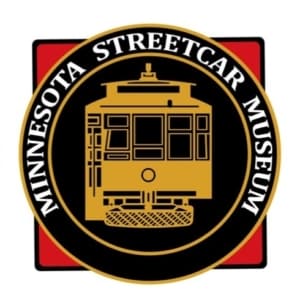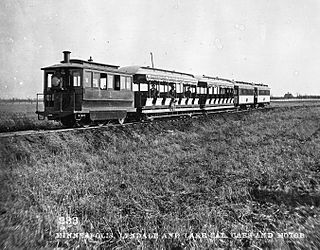
The Twin City Rapid Transit Company (TCRT), also known as Twin City Lines (TCL), was a transportation company that operated streetcars and buses in the Minneapolis-St. Paul metropolitan area in the U.S. state of Minnesota. Other types of transportation were tested including taxicabs and steamboats, along with the operation of some destination sites such as amusement parks. It existed under the TCRT name from a merger in the 1890s until it was purchased in 1962. At its height in the early 20th century, the company operated an intercity streetcar system that was believed to be one of the best in the United States. It is a predecessor of the current Metro Transit bus and light rail system that operates in the metro area.

William Smith King was a Republican U.S. Representative for Minnesota from March 4, 1875 to March 3, 1877. He was a journalist and businessman. He is best known for allegations of political corruption during this congressional term. The House of Representatives did not specify his offense, but decided it was constitutionally unable to punish him for actions that took place before he entered Congress. He did not run for reelection.

Nicollet Avenue is a major street in Minneapolis, Richfield, Bloomington, and Burnsville in the U.S. state of Minnesota. It passes through a number of locally well-known neighborhoods and districts, notably Eat Street in south Minneapolis and the traffic-restricted Nicollet Mall in downtown Minneapolis.

The Minnesota Transportation Museum is a transportation museum in Saint Paul, Minnesota, United States.

The Como-Harriet Streetcar Line (CHSL) is a heritage streetcar line in Minneapolis, Minnesota, which follows original streetcar right-of-way between Lake Harriet and Bde Maka Ska and is operated by the Minnesota Streetcar Museum. The heritage line was originally developed in the 1970s by the Minnesota Transportation Museum which spun off streetcar operations in the winter of 2004-2005.

The Soo Line Railroad is the primary United States railroad subsidiary of the Canadian Pacific Railway, one of seven U.S. Class I railroads, controlled through the Soo Line Corporation. Although it is named for the Minneapolis, St. Paul and Sault Ste. Marie Railroad (MStP&SSM), which was commonly known as the Soo Line after the phonetic spelling of Sault, it was formed in 1961 by the consolidation of that company with two other CP subsidiaries: The Duluth, South Shore and Atlantic Railway, and the Wisconsin Central Railway. It is also the successor to other Class I railroads, including the Minneapolis, Northfield and Southern Railway and the Chicago, Milwaukee, St. Paul and Pacific Railroad. On the other hand, a large amount of mileage was spun off in 1987 to Wisconsin Central Ltd., now part of the Canadian National Railway. The Soo Line Railroad and the Delaware and Hudson Railway, CP's other major subsidiary, presently do business as the Canadian Pacific Railway. Most equipment has been repainted into the CP scheme, but the U.S. Surface Transportation Board groups all of CP's U.S. subsidiaries under the Soo Line name for reporting purposes. The Minneapolis headquarters are located in the Canadian Pacific Plaza building, having moved from the nearby Soo Line Building.

The Minneapolis, Northfield and Southern Railway was an 87-mile (140 km) long American shortline railroad connecting Minneapolis and Northfield, Minnesota. It was incorporated in 1918 to take over the trackage of the former Minneapolis, St. Paul, Rochester and Dubuque Electric Traction Company, also known as the Dan Patch Lines. On June 2, 1982, it was acquired by the Soo Line Railroad, which operated it as a separate railroad until merging it on January 1, 1986 along with the Chicago, Milwaukee, St. Paul and Pacific Railroad.

Lowry Hill East is a neighborhood in southwest Minneapolis, Minnesota, United States, part of the Calhoun Isles community. Lowry Hill East developed in the 1880s along a horse-drawn streetcar line built by Thomas Lowry. The interior of the neighborhood is residential, with large early 20th century homes and multi-unit apartment buildings, while the border streets are lined with bars, restaurants, grocery stores, coffeeshops, and other small businesses. Most housing is renter-occupied.

Big Island Park was a popular tourist destination that existed near Minneapolis, Minnesota between 1906 and 1911 on Lake Minnetonka's Big Island. Today the property is a municipal nature park owned by the City of Orono, sometimes referred to as Big Island Nature Park to distinguish it from the former amusement park.

Lake Street is a major east-west thoroughfare between 29th and 31st streets in Minneapolis, Minnesota United States. From its western most end at the city's limits, Lake Street reaches the Chain of Lakes, passing over a small channel linking Bde Maka Ska and Lake of the Isles, and at its eastern most end it reaches the Mississippi River. In May 2020, the Lake Street corridor suffered extensive damage during local unrest over the murder of George Floyd. In August of the same year, city officials designated East Lake Street as one of seven cultural districts to promote racial equity, preserve cultural identity, and promote economic growth.

The Minnesota Streetcar Museum (MSM) is a transport museum that operates two heritage streetcar lines in Minneapolis, Minnesota and the western suburb of Excelsior.
The Minneapolis Streetcar System was a proposed streetcar system for the city of Minneapolis, Minnesota. Extensive studies and plans for the new system were completed in 2007 and presented to the Minneapolis City Council in January 2008; on April 2, 2010, the Council voted to approve the plans and seek funding. On December 21, 2010 the Federal Transit Administration granted $900,000 to further study the Nicollet and Central Avenue corridors. In June 2021, after no further development on the system, a bill authorized the Metropolitan Council to use funds collected for the Nicollet-Central line to be spent on bus rapid transit funding.

The Minneapolis Great Northern Depot, also known as Great Northern Station, was a passenger railroad station which served Minneapolis, Minnesota, USA. It was built in 1913 and demolished in 1978. It was located on Hennepin Avenue next to the Hennepin Avenue Bridge and across the street from the main Minneapolis Post Office.

The Minneapolis, St. Paul and Sault Ste. Marie Railroad (MStP&SSM) was a Class I railroad subsidiary of the Canadian Pacific Railway in the Midwestern United States. Commonly known since its opening in 1884 as the Soo Line after the phonetic spelling of Sault, it was merged with several other major CP subsidiaries on January 1, 1961 to form the Soo Line Railroad.

Walker Library is a public library in the East Isles neighborhood of Minneapolis, Minnesota, United States. It is on Hennepin Avenue one block north of Lake Street, adjoining the Midtown Greenway.
The MN&S Spur is a 18.5-mile (29.8 km) railroad line operated by the Progressive Rail Inc. The route runs through suburbs immediately west of Minneapolis, Minnesota, from MN&S Junction in Crystal south to Auto Club Junction in Bloomington near the Minnesota River. This path is parallel to Minnesota State Highway 100, which is about half a mile east of the rail line.
Lyndale Avenue is a major street in the U.S. state of Minnesota that traverses the cities of Minneapolis, Brooklyn Center, Richfield, and Bloomington. A noncontiguous portion also exists in Faribault, part of Highway 21. There are several commercial districts along the street, including Lyn-Lake in South Minneapolis, Shops at Lyndale in Richfield, and the Oxboro area in Bloomington. Portions of both Interstate 94 and Interstate 35 run on the right-of-way of Lyndale Avenue.

The Lyndale Railway Company later renamed the Minneapolis, Lyndale, & Minnetonka Railway Company operated the Minneapolis, Lyndale and Lake Calhoun railway, also known as the Motor Line.

Louis Francois Menage was a real estate speculator and prominent figure in early Minneapolis, Minnesota history. Born in Rhode Island, he settled in Minneapolis in 1874. Characterized as a "tycoon" and "robber baron," Menage earned a fortune developing land on the city's borders into residential housing and financing the mortgages to enable people to buy his properties. During the 1870s and 1880s, he developed large areas of South Minneapolis including much of the area around Lake Calhoun and Lake Harriet. He also developed a luxury resort on Lake Calhoun and built a corporate headquarters which was at the time the city's tallest skyscraper.


















